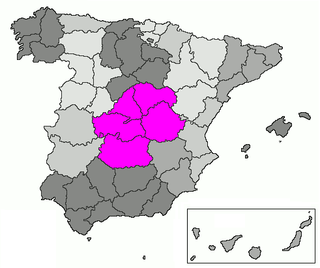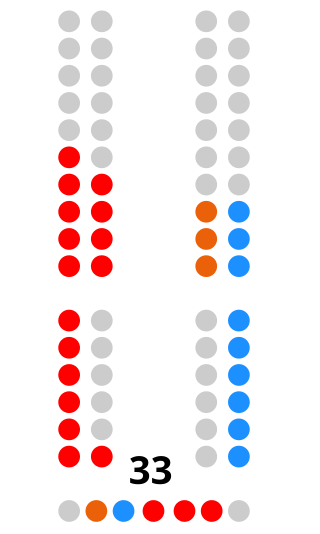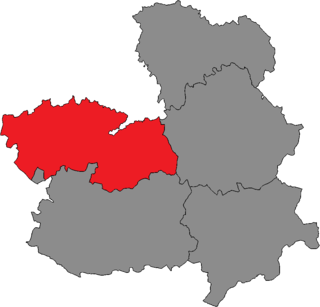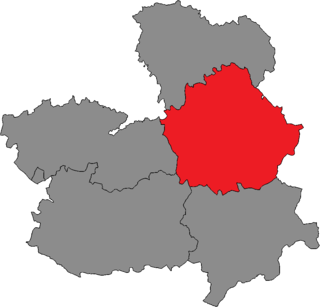Castile or Castille is a territory of imprecise limits located in Spain. The invention of the concept of Castile relies on the assimilation of a 19th-century determinist geographical notion, that of Castile as Spain's centro mesetario with a long-gone historical entity of diachronically variable territorial extension.

Castilla–La Mancha, or Castile La Mancha, is an autonomous community of Spain. Comprising the provinces of Albacete, Ciudad Real, Cuenca, Guadalajara and Toledo, it was created in 1982. The government headquarters are in Toledo, and its largest city is in Albacete.

Albacete is a province of central Spain, in the southern part of the autonomous community of Castile–La Mancha. As of 2012, Albacete had a population of 402,837 people. Its capital city, also called Albacete, is 262 kilometres (163 mi) by road southeast of Madrid.

The province of Ciudad Real is a province in the southwestern part of the autonomous community of Castile-La Mancha, Spain. It is bordered by the provinces of Cuenca, Albacete, Jaén, Córdoba, Badajoz, and Toledo. It is partly located in the old natural region of La Mancha. Its capital is Ciudad Real. It is the third largest province by area in all of Spain, after Cáceres and Badajoz. The historic comarca Campo de Calatrava is located in the center of the province.

New Castile is a historic region of Spain. It roughly corresponds to the historic Moorish Taifa of Toledo, taken during the Reconquista of the peninsula by Christians and thus becoming the southern part of Castile. The extension of New Castile was formally defined after the 1833 territorial division of Spain as the sum of the following provinces: Ciudad Real, Cuenca, Guadalajara, Madrid and Toledo.

Albacete is a city and municipality in the Spanish autonomous community of Castilla–La Mancha, and capital of the province of Albacete.

Elche de la Sierra is a municipality in Albacete, Castile-La Mancha, Spain. This province belongs to the autonomous community of Castilla-La Mancha. It had a population of 3,944 at the beginning of 2010 as reported by the country's National Statistics Institute.

Villalgordo del Júcar is a municipality in Albacete, Castile-La Mancha, Spain. It has a population of 1,275. Palacio de los Gosálvez was built in 1902 by Enrique Gosálvez.

Mancheguian regionalism is a minoritarian political current in Spain that proposes the existence of a differentiated historical region in La Mancha with its proper legal entity, against the Pancastilian thesis that considers Castile as a unique nation or region. Very minority currents inside the Mancheguian Regionalism supports to go beyond the regionalism by a total rupture with Spain.

The Cortes of Castilla–La Mancha is the unicameral legislature of Castilla–La Mancha, an autonomous community of Spain. The Cortes consists of 33 elected deputies. The Cortes of Castilla–La Mancha represent the popular will through 33 deputies elected by universal adult suffrage through the secret ballot.

The 2019 Castilian-Manchegan regional election was held on Sunday, 26 May 2019, to elect the 10th Cortes of the autonomous community of Castilla–La Mancha. All 33 seats in the Cortes were up for election. The election was held simultaneously with regional elections in eleven other autonomous communities and local elections all throughout Spain, as well as the 2019 European Parliament election.

Albacete is one of the five constituencies represented in the Cortes of Castilla–La Mancha, the regional legislature of the autonomous community of Castilla–La Mancha. The constituency currently elects six deputies. Its boundaries correspond to those of the Spanish province of Albacete. The electoral system uses the D'Hondt method and a closed-list proportional representation, with a minimum threshold of three percent.

Toledo is one of the five constituencies represented in the Cortes of Castilla–La Mancha, the regional legislature of the autonomous community of Castilla–La Mancha. The constituency currently elects nine deputies. Its boundaries correspond to those of the Spanish province of Toledo. The electoral system uses the D'Hondt method and a closed-list proportional representation, with a minimum threshold of three percent.

Ciudad Real is one of the five constituencies represented in the Cortes of Castilla–La Mancha, the regional legislature of the autonomous community of Castilla–La Mancha. The constituency currently elects eight deputies. Its boundaries correspond to those of the Spanish province of Ciudad Real. The electoral system uses the D'Hondt method and a closed-list proportional representation, with a minimum threshold of three percent.

Cuenca is one of the five constituencies represented in the Cortes of Castilla–La Mancha, the regional legislature of the autonomous community of Castilla–La Mancha. The constituency currently elects five deputies. Its boundaries correspond to those of the Spanish province of Cuenca. The electoral system uses the D'Hondt method and a closed-list proportional representation, with a minimum threshold of three percent.

Guadalajara is one of the five constituencies represented in the Cortes of Castilla–La Mancha, the regional legislature of the autonomous community of Castilla–La Mancha. The constituency currently elects five deputies. Its boundaries correspond to those of the Spanish province of Guadalajara. The electoral system uses the D'Hondt method and a closed-list proportional representation, with a minimum threshold of three percent.

The flag of Castilla–La Mancha is one of the representative symbols of the Autonomous Community of Castilla–La Mancha, in Spain, defined by its Statute of Autonomy.
The Office of the Public Prosecutor was created in the Autonomous communities of Spain by Royal Decree 1754/2007 of December 28.

Francisco Pardo is a Spanish politician serving as Director-General of the Police since June 1, 2018. Pardo is a member of the Spanish Socialist Workers' Party and he has previously served as the 8th Secretary of State for Defence from 2004 to 2007.

María del Carmen Picazo Pérez is a Spanish lawyer and politician for the Citizens party. She has led the party in the Cortes of Castilla–La Mancha since her election in 2019.


















